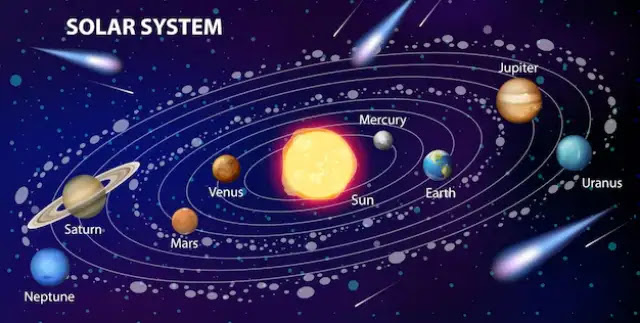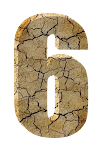Facts about Solar System: The Solar System is a vast and mysterious place, filled with a wide variety of fascinating objects and phenomena. From the massive and powerful sun at its center, to the diverse array of planets, moons, comets, and asteroids that orbit it, there is always something new and interesting to learn about this incredible place we call home. In this article, we will explore 100 of the most fascinating facts about the Solar System, delving into its history, geology, and physics to gain a deeper understanding of the workings of our cosmic neighborhood.
100 Interesting Facts about the Solar System
The Sun:
- The sun is a star at the center of the solar system
- It is a near-perfect sphere of hot plasma
- The sun's core temperature is about 15 million degrees Celsius
- The sun is about 4.6 billion years old
- The sun's energy is generated by nuclear fusion
- The sun's surface is called the photosphere
- The sun's atmosphere is divided into three parts: the photosphere, the chromosphere, and the corona
- The sun's outer atmosphere, the corona, is much hotter than its surface
- The sun has a 11-year solar cycle during which its activity increases and decreases
- The sun's magnetic field is responsible for solar flares and sunspots.
The Planets:
- There are eight planets in the solar system
- Four of the planets are made mostly of gas (Jupiter, Saturn, Uranus, and Neptune)
- Four of the planets are made mostly of rock and metal (Mercury, Venus, Earth, and Mars)
- The four inner planets (Mercury, Venus, Earth, and Mars) are also called the terrestrial planets
- The four outer planets (Jupiter, Saturn, Uranus, and Neptune) are also called the gas giants
- Jupiter is the largest planet in the solar system
- Earth is the only planet known to support life
- Venus and Uranus rotate in the opposite direction of the other planets
- Mars is known as the "Red Planet" because of its reddish appearance
- Saturn's rings are made of ice particles, rocks and dust.
The Moon:
- The moon is Earth's only natural satellite
- The moon is about 384,400 kilometers away from Earth
- The moon's surface is covered with craters, mountains, and flat plains
- The moon's surface is also covered with a layer of fine dust called regolith
- The moon's surface is constantly bombarded by meteoroids
- The moon's surface temperature varies from about -173 degrees Celsius at night to 127 degrees Celsius during the day
- The moon has no atmosphere or magnetic field
- The moon has a large, circular basin called the Imbrium Basin
- The moon has been visited by eight spacecrafts
- The moon's surface has been explored by 12 astronauts.
Comets and asteroids:
- Comets are made mostly of ice and dust
- As comets get close to the sun, they start to "melt" and release gas and dust
- This gas and dust forms a "coma" around the comet's nucleus
- The gas and dust also forms a long tail that points away from the sun
- Comets are often called "dirty snowballs"
- Asteroids are made mostly of rock and metal
- Most asteroids orbit the sun in a region called the asteroid belt between Mars and Jupiter
- Asteroids can range in size from small pebbles to large mountains
- Some asteroids are thought to be the remains of a planet that never formed
- Some asteroids have their own moons.
The Kuiper belt and Oort cloud:
- The Kuiper belt is a region of the solar system beyond Neptune
- It is made up of small objects made mostly of ice, including comets, dwarf planets, and other small bodies
- The Kuiper belt is thought to be the source of many comets that visit the inner solar system
- The Oort cloud is a region of the solar system even farther out than the Kuiper belt
- It is made up of small objects made mostly of ice, including comets, and other small bodies
- The Oort cloud is thought to be the source of many long-period comets that visit the inner solar system
- The Oort cloud is estimated to be about 100,000 AU away from the sun
- The Kuiper belt and Oort cloud were first proposed by Dutch astronomer Jan Oort in 1950
- The Kuiper belt was first discovered in 1992
- Some objects from the Kuiper belt are classified as "plutoids" and include Pluto, Eris, and Ceres
- The Kuiper belt is estimated to contain more than 100,000 objects larger than 100 km in diameter
- The Oort cloud is estimated to contain trillions of comets.
The Solar wind:
- The solar wind is a stream of charged particles (mostly protons and electrons) that flows out from the sun
- It is caused by the high temperature and pressure in the sun's corona
- The solar wind can reach speeds of up to 700 km/s
- The solar wind creates a "bubble" around the solar system called the heliosphere
- The solar wind's pressure causes the tail of a comet to point away from the sun
- The solar wind can cause auroras on Earth and other planets
- The solar wind can also cause problems for satellites and power grids on Earth
- The solar wind can also affect the atmospheres of other planets
- The solar wind can also create radiation belts around planets.
The International Space Station:
- The International Space Station (ISS) is a space station in low Earth orbit
- It is a collaboration between NASA, the Russian Space Agency, the European Space Agency, and other partners
- The ISS has been continuously occupied since 2000
- The ISS orbits Earth about once every 90 minutes at an altitude of about 400 km
- The ISS is the largest artificial object in space
- The ISS is used for scientific research and as a testbed for technology development
- The ISS is also used as a stepping stone for human exploration of the solar system
- The ISS is visited by spacecrafts from different countries including the Russian Soyuz and Progress spacecraft and the American Space Shuttle and SpaceX Dragon
- The ISS has a pressurized volume of about 916 cubic meters, which is roughly the same as a 747 jumbo jet.
- The ISS has a mass of around 925,000 kg.
Space Exploration and technology:
- The first artificial satellite, Sputnik 1, was launched in 1957 by the Soviet Union
- The first human in space was Yuri Gagarin in 1961
- The first human landing on the moon was by Neil Armstrong and Buzz Aldrin in 1969
- NASA's Mars rover, the Curiosity, has been exploring Mars since 2012
- NASA's New Horizons spacecraft flew by Pluto in 2015
- NASA's Parker Solar Probe is currently studying the sun up close
- NASA's Artemis program aims to land humans on the moon again in 2024
- NASA's Perseverance rover landed on Mars in February 2021
- NASA's James Webb Space Telescope is set to launch in 2021
- NASA's Artemis program aims to establish a sustainable human presence on the moon by the end of the decade.
Black Holes and Dark Matter:
- Black holes are extremely dense regions in space where gravity is so strong that nothing, not even light, can escape
- Black holes are thought to form when massive stars die and their cores collapse
- Black holes can be classified by their size: stellar black holes are formed from the collapse of a single star, intermediate black holes are formed from the collapse of a group of stars, and supermassive black holes are found at the center of most galaxies
- The existence of black holes is inferred from their effects on nearby matter and radiation
- Dark matter is a hypothetical form of matter that is thought to make up about 85% of the universe's total matter
- Dark matter does not interact with electromagnetic force, which makes it invisible to telescopes
- Dark matter is detected through its gravitational effects on visible matter
- The nature and properties of dark matter are still not well understood
- Scientists are currently searching for dark matter particles using underground detectors
- Some theories suggest that dark matter could be composed of Weakly Interacting Massive Particles (WIMPs)
- Some theories suggest that dark matter could be composed of axions or other hypothetical particles.
Solar System's future:
- The sun is expected to exhaust its hydrogen fuel in about 5 billion years
- The sun will then expand into a red giant and possibly swallow the inner planets, including Earth
- After the sun exhausts its fuel it will shrink to become a white dwarf
- The fate of the outer planets is less clear, but they may also be affected by the sun's evolution
- The asteroid belt and Kuiper belt will continue to exist for trillions of years
- The solar system will continue to interact with other stars and galaxies through its orbit in the Milky Way
- The Oort cloud will continue to provide comets to the inner solar system
- The heliosphere will continue to protect the solar system from interstellar radiation
- The solar system will continue to evolve until the sun exhausts its fuel and becomes a white dwarf
- The solar system will continue to move around the Milky Way galaxy for trillions of years.
Conclusion:
The Solar System is an endlessly fascinating and mysterious place, filled with a wide variety of objects and phenomena that continue to captivate scientists and the public alike. From the massive and powerful sun at its center, to the diverse array of planets, moons, comets, and asteroids that orbit it, there is always something new and interesting to learn about this incredible place we call home. This article has highlighted 100 of the most fascinating facts about the Solar System, providing a glimpse into its history, geology, and physics, and hopefully sparking an interest in exploring the mysteries of our cosmic neighborhood.














0 Comments